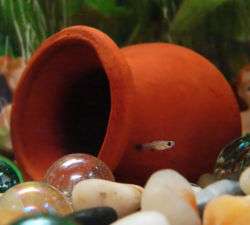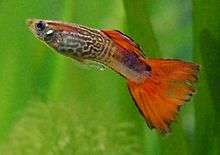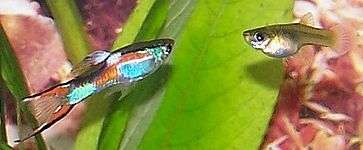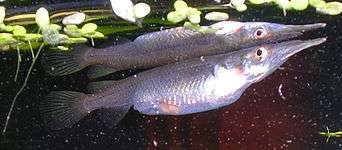Live-bearing aquarium fish

Live-bearing aquarium fish, often simply called livebearers, are fish that retain the eggs inside the body and give birth to live, free-swimming young. Among aquarium fish, livebearers are nearly all members of the Poeciliidae family and include guppies, mollies, platies and swordtails.
The advantages of livebearing to the aquarist are that the newborn juvenile fish are larger than newly-hatched fry, have a lower chance of mortality and are easier to care for. Unusual livebearers include seahorses and pipefish, where the males care for the young, and certain cichlids that are mouthbrooders, with the parent incubating the eggs in the buccal cavity.
Common aquarium livebearers
Species of interest to aquarists are almost always members of the family Poeciliidae, most commonly guppies, mollies, platies, swordtails, Endler's livebearer, and mosquito fish. Most of these are ovoviviparous, with the developing embryos receiving no nourishment from the parent fish, but a few are viviparous, receiving food from the maternal blood supply.
Live-bearing aquarium fish, often simply called livebearers, are fish that retain the eggs inside the body and give birth to live, free-swimming young. Because the newborn fish are large compared to the fry of oviparous fish, they are easier to feed than the fry of egg-laying species, such as characins and cichlids. This makes them much easier to raise, and for this reason, aquarists often recommend them for beginners to fish breeding. In addition, being much larger makes them far less vulnerable to predation, and with sufficient cover, they can sometimes mature in a community tank.
Ovoviviparous and viviparous fish compared
Most of the Poeciliidae are ovoviviparous, that is, while the eggs are retained inside the body of the female for protection, the eggs are essentially independent of the mother and she does not provide them with any nutrients. In contrast, fish such as splitfins and halfbeaks are viviparous, with the eggs receiving food from the maternal blood supply through structures analogous to the placenta of placental mammals.
Aberrant livebearers and mouthbrooders
Seahorses and pipefish can be defined as livebearers, although in these cases the males incubate the eggs rather than the females. In many cases, the eggs are dependent on the male for oxygen and nutrition, so these fish can be further defined as viviparous livebearers.
Many cichlids are mouthbrooders, with the female (or more rarely the male) incubating the eggs in the buccal cavity. Compared with other cichlids, these species produce fewer but bigger eggs, and when they emerge, the fry are better developed and have a higher survivability. Because the eggs are protected from the environment but do not absorb nutrients from the parent, this condition is analogous to, though not identical with, ovoviviparity.
Livebearer fish gallery
External links
- American Livebearer Association
- British Livebearer Association
- Keeping & Breeding Halfbeaks Includes growth rate chart and pictures of newborn fish.
- How to Keep Livebearers




